The stage was set in Brighton on the South Coast as the Lionesses prepared to battle La Roja at the American Express Stadium.
While the nation basked in blissful, blistering and perilous heat, a fully COVID-recovered Sarina Wiegman led to her team out against a Spanish side much more climatised to the sweltering summer sun.
A place in the semi-finals was up for grabs. The tournament hosts had the nation behind them but were facing their sternest test so far. Spain had never won a knockout game in Women’s Euros history, but Wednesday was as good a day as any to break the curse. Interestingly, the last team that England failed to beat in any competition, and score against for that matter, were Spain.
Despite the absence of Alexia Putellas, who could do little but watch her teammates from the metaphorical side-lines, the quality on display was truly a joy to behold. And the game certainly didn’t disappoint.
It was England who came out on top with a 2-1 victory after extra-time, maintaining their perfect record throughout the competition to sail through to the semis, while Jorge Vilda’s side crashed out prematurely.
Having been 1-0 down for most of the game, superheroine Ella Toone saved the day in the 84th minute, which was followed by a truly gorgeous strike from Georgia Stanway in the first half of extra-time to seal the nervy win.
This article will be a tactical analysis of the clash between two great minds on the touchline. This analysis will look at the tactics used by both head coaches which led to the end result.
Lineups and formations
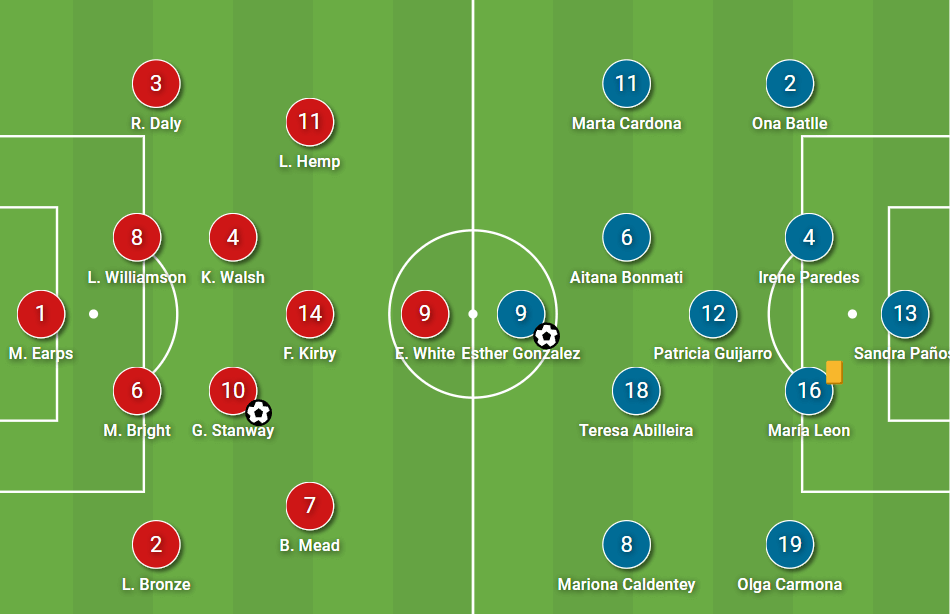
After trouncing Northern Ireland 5-0 at the weekend and sending Kenny Shiels’ side packing, Wiegman saw no need to change the starting eleven or usual 4-2-3-1 formation. If it ain’t broke, don’t fix it!
Mary Earps was chosen by the Dutch coach between the sticks, protecting the backline behind a defensive four comprising of Lucy Bronze, Millie Bright, Leah Williamson and Rachel Daly.
Keira Walsh, Georgia Stanway and Fran Kirby made up a technically-gifted midfielder three while an exciting attacking trio of Arsenal star Beth Mead, and Manchester City’s Laura Hemp and Ellen White made up the forward line.
For Spain, sticking with his typical 4-3-3, Vilda made four changes from Spain’s side that narrowly defeated Denmark in the final game of the group phase.
Lela Ouahabi, Athenea del Castillo, Lucia Garcia and Sheila Garcia had all been dropped to the bench with the goalscorer against Denmark Marta Cardona coming into the starting eleven.
Fullback Olga Carmona, central midfielder Teresa Abelleira and centre-forward Esther Gonzalez were the other three that came into the side.
Spanish press causing trouble
Football, like all history, is written by the victors. It would be easy to sit here and claim that a deserving England conquered a valiant Spain after a close-knit battle on the pitch after 120 minutes to suit the winning narrative, but when analysing games, it’s important that context is applied.
In truth, for large parts of the game, Spain were the dominant team as Wiegman’s England desperately struggled to get to grips with the Spanish high press in particular.
The Lionesses set up in a 4-2-3-1 but this shifted into more of a 4-3-3 during the attacking phases, with Stanway pushing up between the lines, leaving Walsh as the lone pivot.
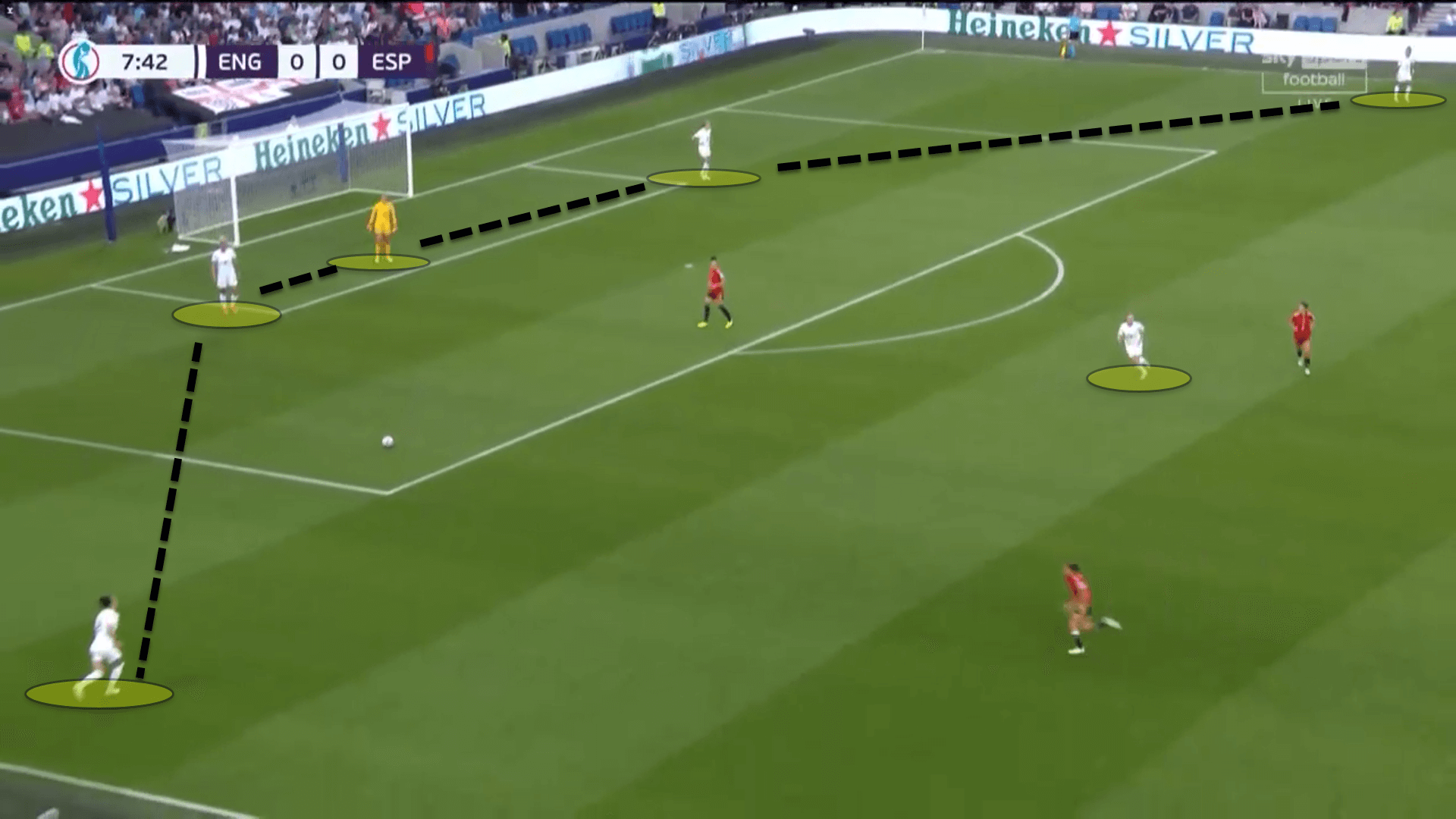
There was nothing unconventional about Spain’s pressing. Their high block was initially zonal, with the centre-forward Gonzalez tasked with angling her pressure to block off the passing lane to one of the centre-backs.
This was typically Williamson. Gonzalez would run at Bright when she had possession of the ball, cutting off the angle to Williamson, forcing the centre-back to play out to Bronze on the right.
Meanwhile, Aitana Bonmati would then push up out of the midfield line during this phase to go player-for-player against Walsh, creating a shape resemblant to a 4-2-3-1 which made sense since the 4-2-3-1 matches up really well against a 4-3-3 with a single pivot in the high press.
From there, Spain’s pressing application would change. Vilda’s side would switch from a zonal press into one which was player-oriented and very tight to box the English in and use the touchline as an extra defender.
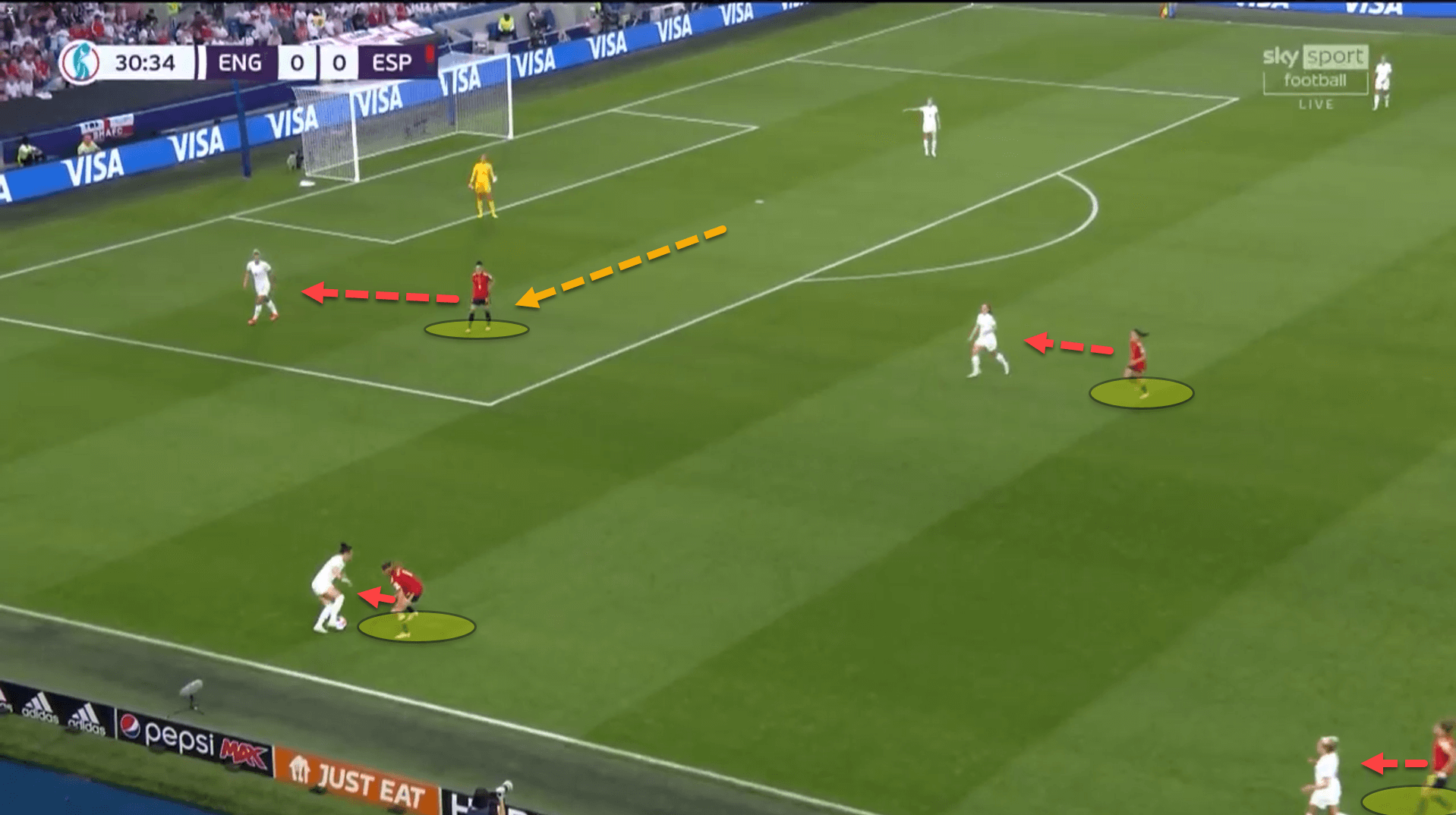
Particularly in the first half, Spain’s pressing was wonderful, causing England a lot of problems. There were several times in the opening 45 minutes where the Lionesses attempted to play out from the back but were halted before they even reached the middle third of the pitch.
Spain’s aggression and intensity were very present, and England were forced to change their approach slightly. While England may have been allowed to have more time on the ball in the first fifteen minutes, Spain’s Passes allowed Per Defensive Action (PPDA) drastically changed as the English were able to make fewer passes per possession as the game wore on.
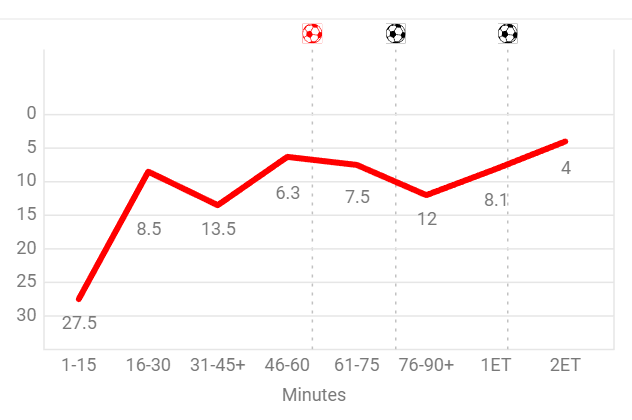
Spain’s pressing was smart. By having Bonmati push higher and sit on Walsh while forcing their play wide, Walsh’s influence on the game was limited and England really struggled to play through the central areas.
Looking at Spain’s defensive duels throughout the game, they won the majority, with most coming on the flanks, a true testament to their defensive approach.
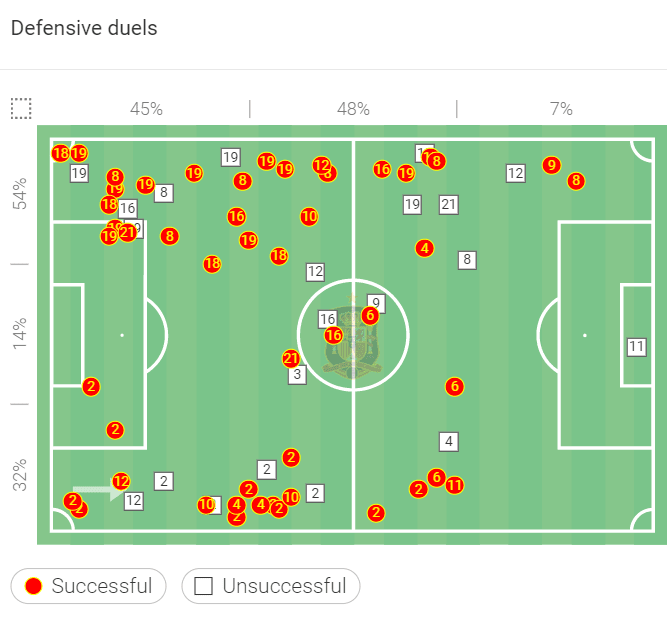
However, after the half-hour mark, Wiegman instructed her players to start playing a little longer, trying to hit the front three from direct passes out of the first third.
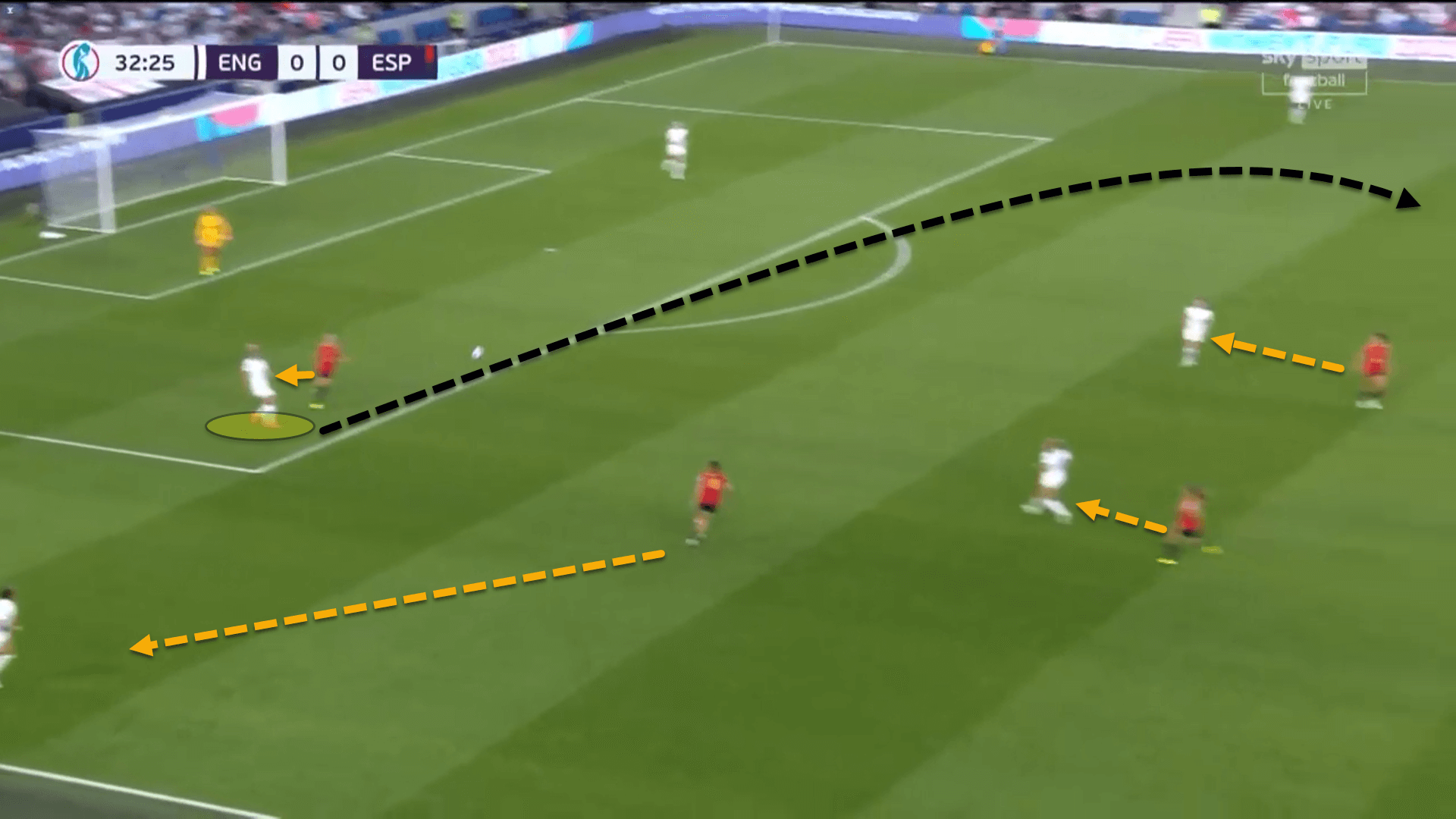
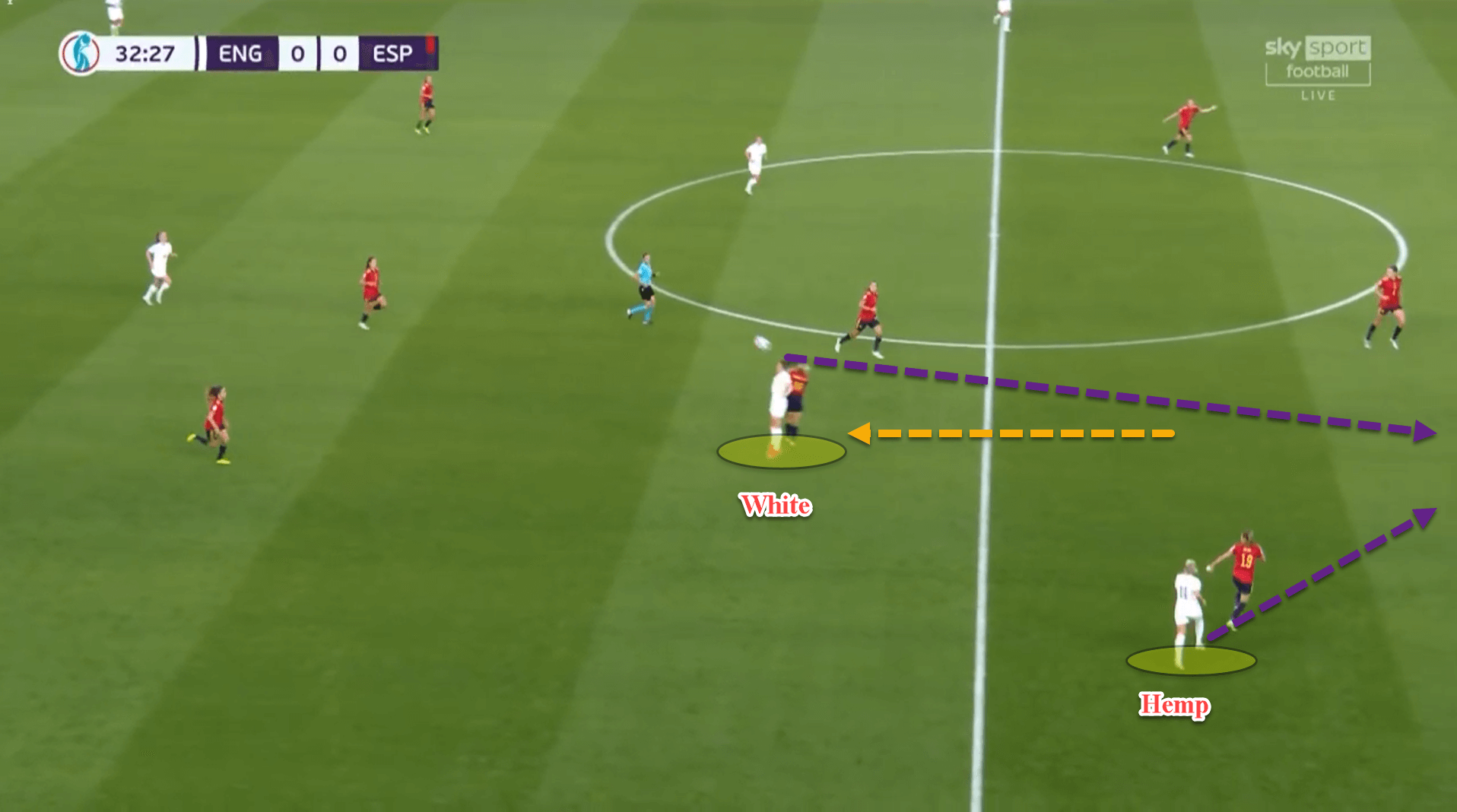
Perhaps this can be seen as another battle won for Spain as England were forced to bypass their incredible technically-gifted midfielders and play more direct.
Although, it can also show that England are able to be flexible with their attacking approach, capable of going long as well as passing out from deep. It all depends on whether you view the glass as half full or half empty.
Nevertheless, England’s attacking approach did change. Over the past calendar year, the Lionesses average percentage of long passes per 90 was 7.04 percent in all competitions. Against Spain, this almost doubled to 13.29 percent. They also averaged merely 3.35 passes per possession in this game, a drop from their usual 5.28.
Looking at England’s progressive passing map from the game, going long to the forward line was their most used method of progressing the ball.
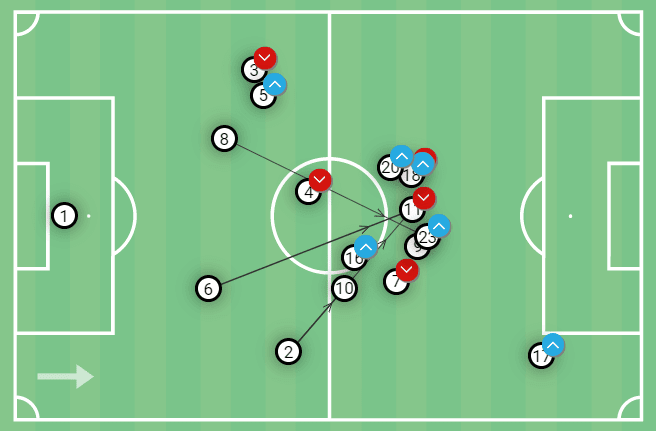
Spain’s possession approach
Spain’s approach in the defensive phases for large parts of the match was pretty spot on as Vilda seemed to have bested Wiegman in many respects. But the Spanish were also the dominant team on the ball and especially dictated the first half.
Throughout the match, Spain held 57.78 percent of the ball overall to England’s 42.22 percent. Breaking the game down into different fifteen-minute segments, there was just one time period where Vilda’s side had less than 50 percent. Coincidentally, or perhaps not, England scored the equaliser during this spell.
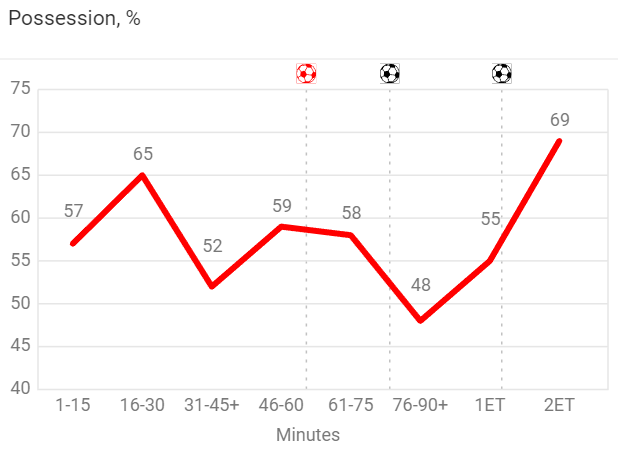
Spain employed their usual 4-3-3 in possession with Guijarro operating as the sole pivot while Bonmati and Abilleira pushed further forward between the lines.
The shape was similar to England’s, and funnily enough, the hosts’ defensive plan was quite resemblant to their opponents as well with Kirby sitting on the pivot player and White cutting off one side of the pitch through her pressing. The only difference was that Spain were far more expressive on the ball and carved England open quite a lot.
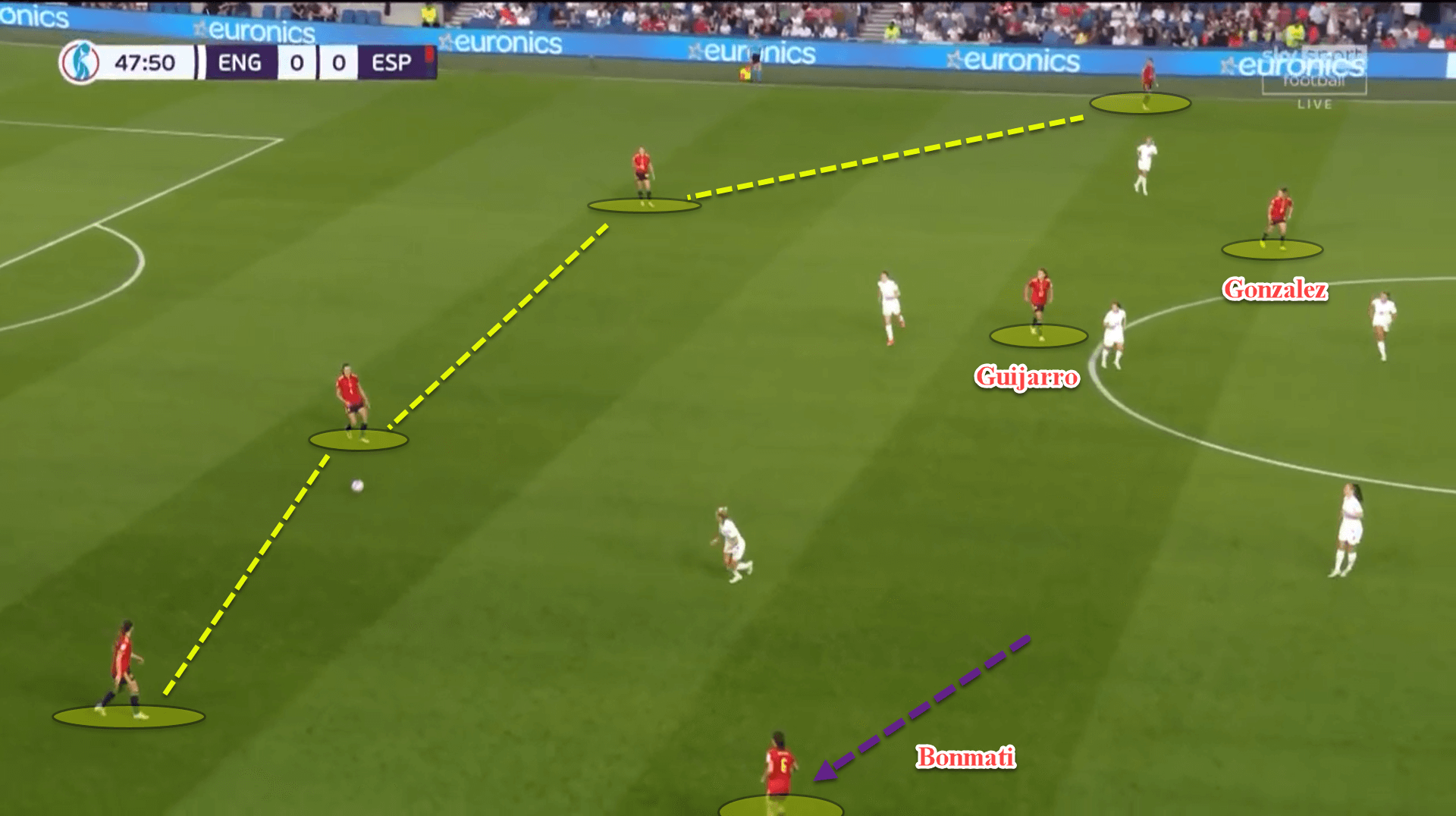
The five players that were positioned ahead of Guijarro were far more willing to drop into different spaces to collect the ball from the backline and pivot player against England’s settled defensive block. If they couldn’t receive the ball in the deeper areas, the two central midfielders and front three would often make runs in behind instead.
Vilda’s team were constantly looking to progress the ball forward up the pitch and were not afraid to hit a channel ball to one of the wingers or advanced midfielders that were running in behind England’s higher backline.
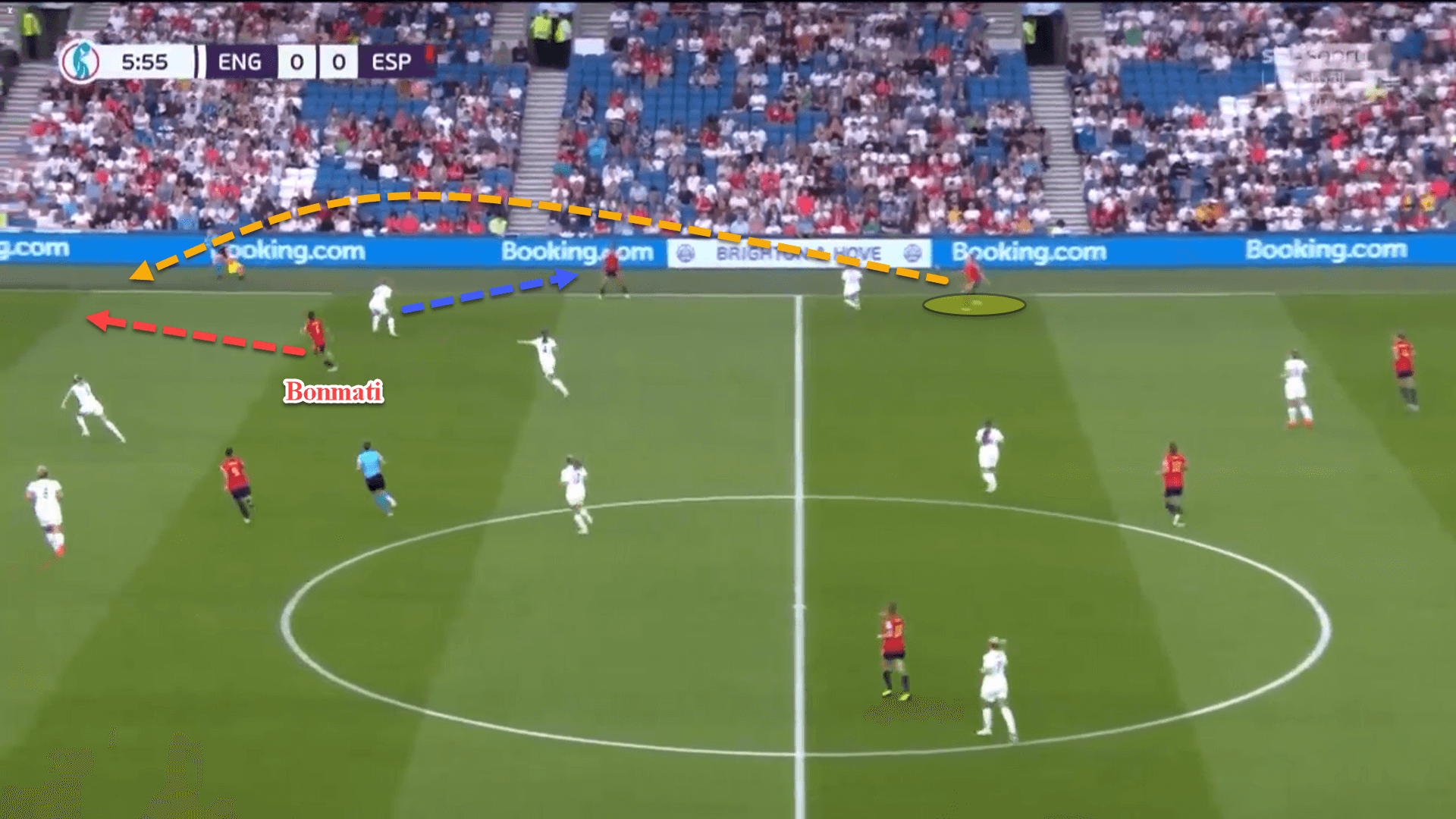
In the image before this, Bonmati had dropped to the deeper wide areas to be a passing option for the backline. Whereas in this example, Daly has stepped across to keep tight to Marta Cardona on the right, and noticing the space open up between Daly and Williamson, Bonmati makes a darting run in behind in this channel to advance the ball quickly up the pitch.
Vilda’s players always looked for the first pass forward, and only when this ball wasn’t on, would they recycle possession.
England’s tweaks taking the victory
For the most part, Spain attacked through the wide areas, especially down the right. Daly struggled greatly to deal with the constant movement of Cardona, Bonmati and Manchester United‘s Ona Battle. In fact, the goal came down this side.
But it was when Cardona was replaced with Athenea del Castillo on the right-wing that trouble really began for the Lionesses. The 21-year-old Real Madrid star wreaked havoc on Daly, flooring her for the goal and putting a nice ball into the feet of Gonzalez who placed it into the bottom left corner.
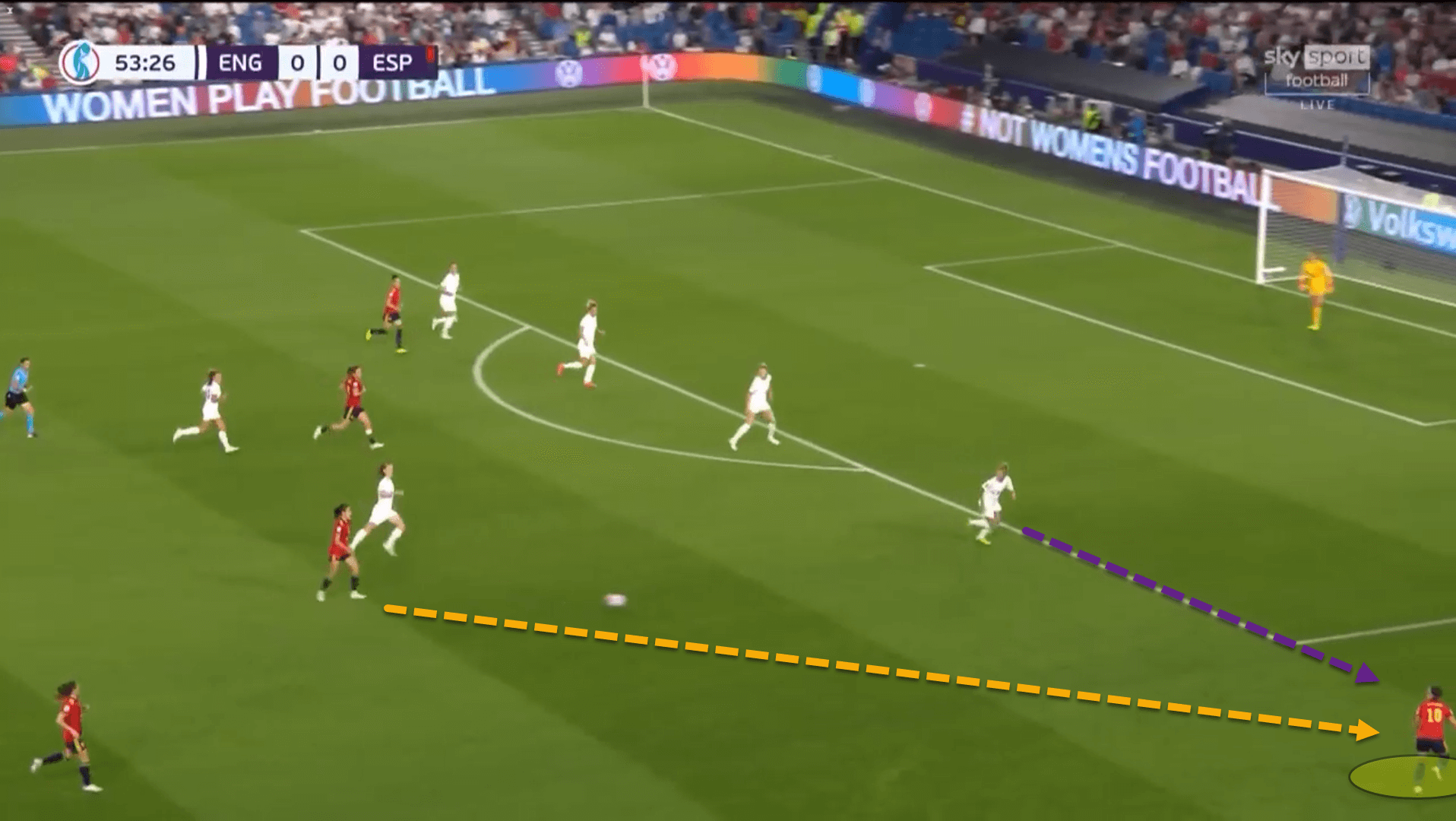
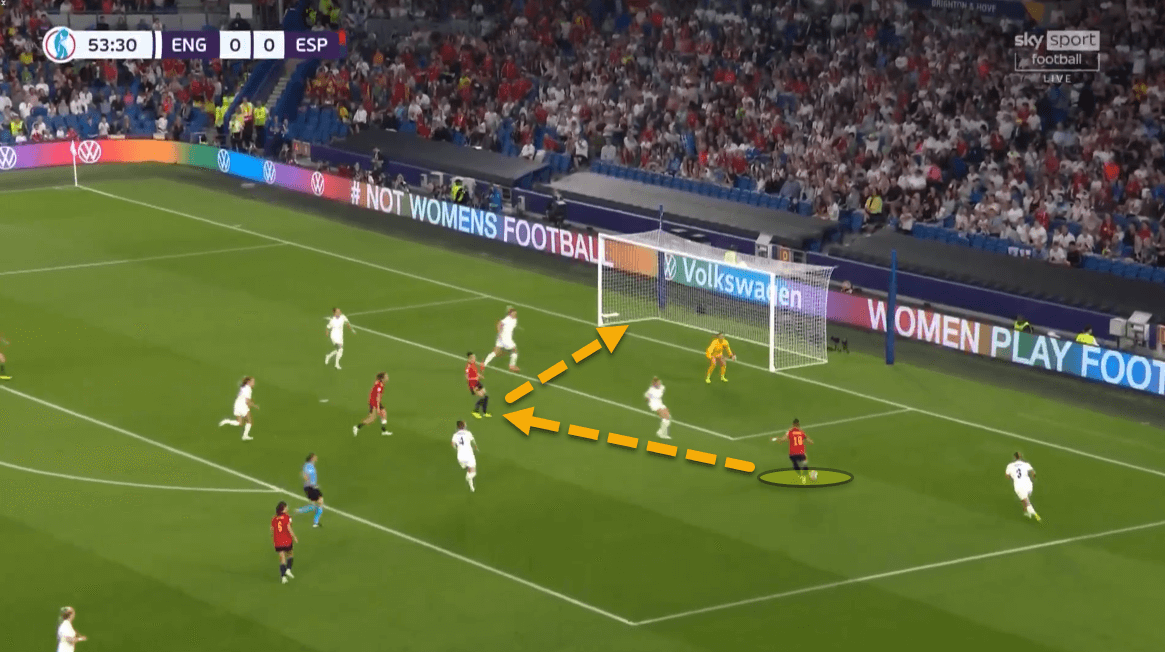
It was squeaky bum time for England. The host nation were heading for a premature exit from the tournament they seemed destined to win.
Vilda had got the best of Wiegman who seemingly had no answers to the Spanish control. But sometimes in football, there is no obvious solution to a problem. Often, luck is needed but forcing luck rather than waiting for it is the best way to reap its rewards. Wiegman did just this with her substitutions.
From the 59th to the 64th minute, the Dutch coach replaced three of her front four, bringing Ella Toone, Chloe Kelly and Alessi Russo onto the pitch to try and force the issue.
As spoken about in a previous section, England became the dominant possession side for the last fifteen minutes of normal time, holding 52 percent of the ball on average. Knocking, knocking, knocking, the door was finally opened from Toone who poked home after a Russo flick-on to equalise.
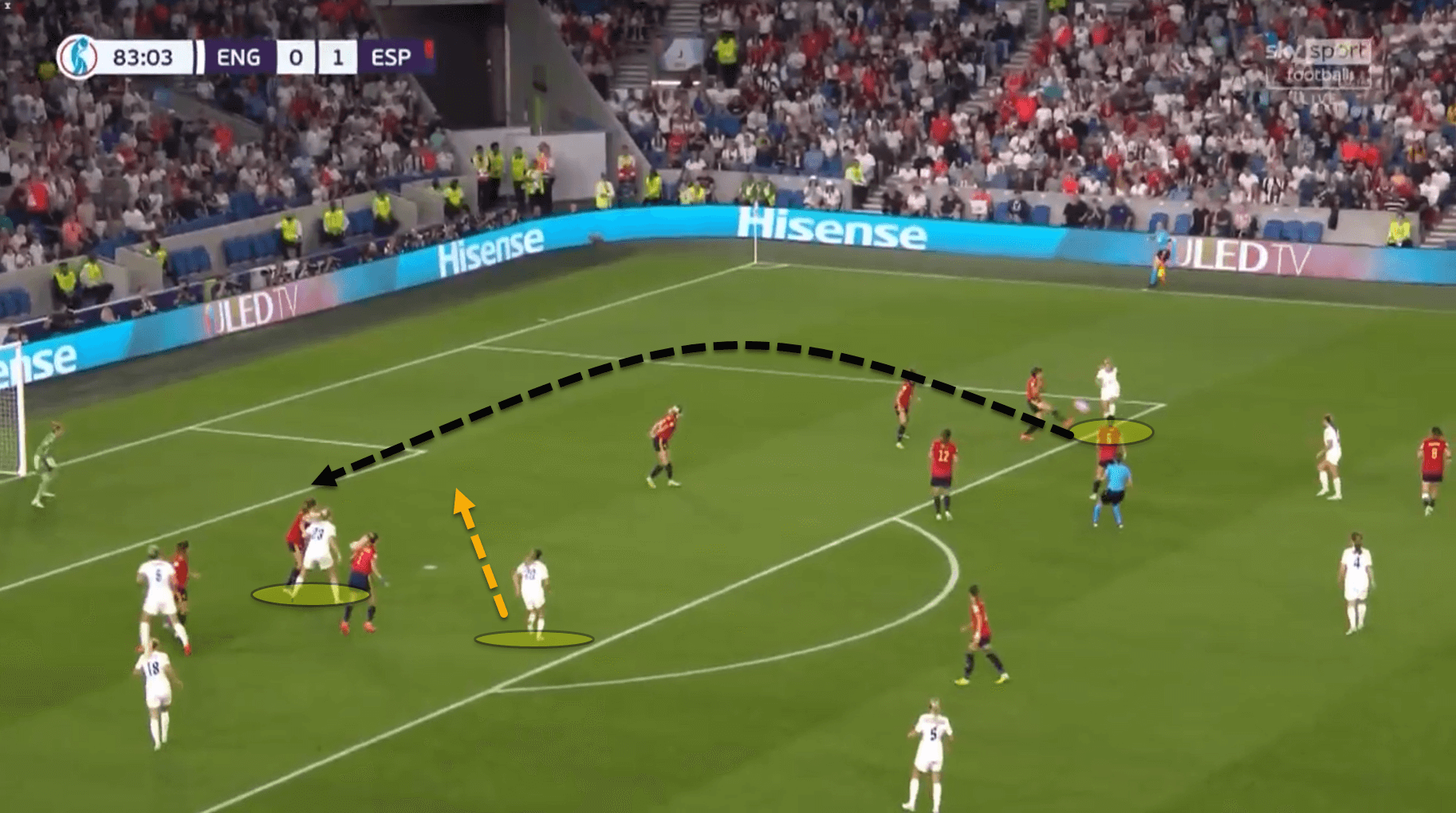
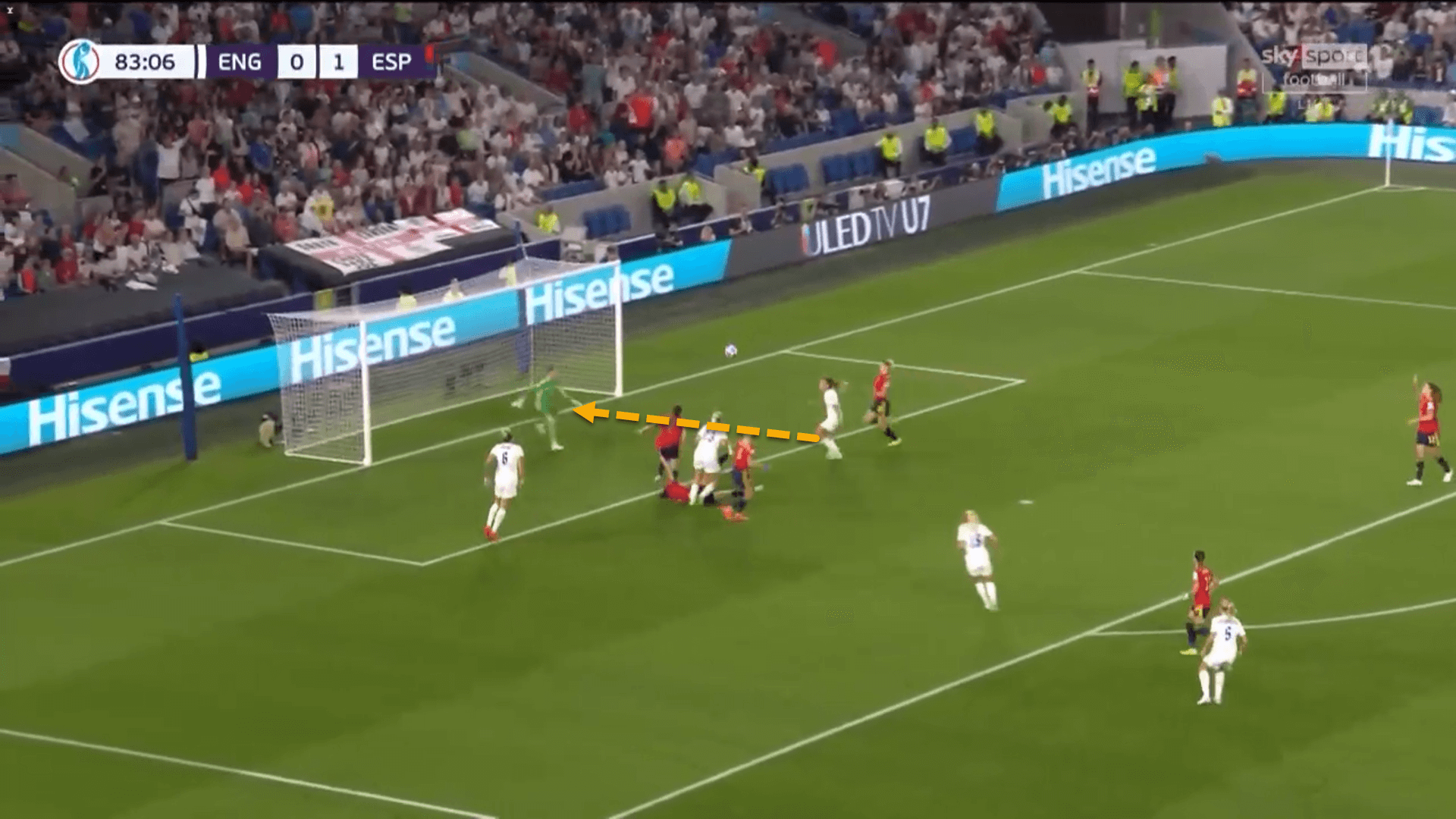
One of the final tweaks Wiegman made to ensure that the victory was clenched in the end was to replace Daly at left-back. Alex Greenwood was her replacement late in the second half.
Daly is an excellent footballer and a wonderful defender. However, Wednesday night certainly wasn’t her strongest performance, especially after the interval when Athenea del Castillo came on for Spain.
Greenwood nullified Athenea and was much more assured at the back, winning 67 percent of her aerial duels, 4 interceptions, and 100 percent of her 5 defensive duels in the 48 minutes she was on the pitch.
Conclusion
Midway through the first half of extra-time, after some quick transitional play, Stanway found herself in a plethora of space outside the penalty area. With Spain’s defenders backing off in anticipation of a slipped through ball, Stanway unleashed a shot with more heat than the boiling sun that battered the South Coast, beating the goalkeeper.
The game would end 2-1. Spain were perhaps hard done by, but as the cliché goes in football, winners find a way to win. Wiegman’s tactical changes may not have been too outrageous and were a little obvious, but the former Netherlands boss still made them, earning her coin for the afternoon.
It’s onwards and upwards for England who are preparing for their semi-final clash early next week while Spain walked away with their heads held high. What an afternoon of women’s football. Not bad for a sport of such low quality, eh, Simon Jordan?





Comments